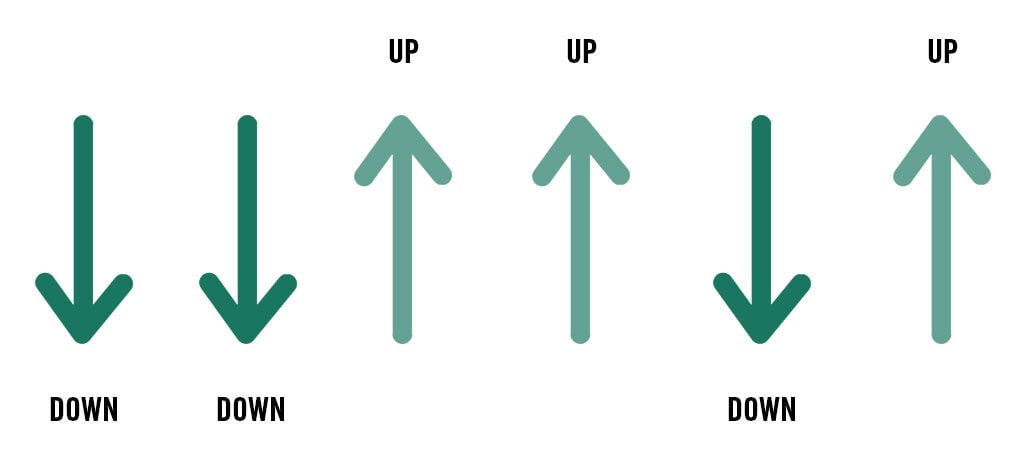Tips & Tutorials | December 22, 2021
Picking vs. Strumming
by Cliff Hall
I remember Helen, my first guitar teacher in high school. Sitting in her wood-paneled living room and playing some no-name classical guitar, she showed me this strumming pattern:

And I was hooked. I took to doing it on the bus, in math class, anywhere I could practice it. This was my introduction to the guitar.
Now as a bluegrass player, I don’t strum so much when I am concentrating on learning some 'hot leads.' My mantra of late has been "let’s pick."
So what is the difference? Let’s explore.
Strumming is basically when you fret a chord and you play all the strings of the guitar (or at least the ones that are in the chord) with a rhythmic pattern (like the one illustrated above). And there is a whole world in rhythm playing. Del McCoury, one of the legendary rhythm guitar players, knows a thing or two about the practice.
Bill Monroe & Bluegrass Boys - Can't You Hear me Calling (Opry, 1963)
"I learned a lot from Bill Monroe. When we did play on a microphone he’d say, "Get in there and crowd me" because he needed that rhythm up there with him. So I learned to play hard rhythm. And about the only guitars that would hold up to that hard rhythm and not lose their tone were Martins," said McCoury in a 2018 interview in Acoustic Guitar magazine. "I played behind a fiddle a lot at square dances in the early years, where you had to play all night long. When you’re playing that much rhythm guitar you've got to learn how to use your wrist in the right way, and you'll do that if you play long enough. Because if you use your arm too much you can't last on a square dance. I learned that from Bill Monroe, too. He was the same way on that mandolin: It was all in his wrist; it was all right there."
What Del is talking about is similar to what I teach my students: Power Through Relaxation. If you stiffen up your wrist too much and rely on your arm to do all the strumming, you’re going to get tired very quickly. The key here is to hold your pick as lightly as possible without dropping it. It's the players who squeeze the pick between their thumb and first finger as hard as they can who drop out first in the longer jam sessions.
And now we come to picking, which is a technique of playing individual notes (with your fingers or a guitar pick) instead of the whole chord. I started this journey by doing my best to copy R.E.M.'s guitarist Peter Buck. He would often break a basic chord into the separate notes rather than strumming them all at once. Known as arpeggios, they got their name from the Italian word for harp because picking individual notes is what harpists spend most of their time doing.
From the folksy balladeer's gentle fingerpicking to the aggressive pick sweeps of a metal shredder, picking is a style that takes many forms. Martin Guitar artist Kenneth Pattengale of the Milk Carton Kids typically has a delicate style but is not afraid to push it in a grittier country direction like he does in their song "Younger Years" off of 2017's All the Things That I Did and All the Things That I Didn’t Do.
The Milk Carton Kids - "Younger Years"
Now if you really want to up your picking game, some say practicing your scales is a key part of that study. Essentially, scales are a series of notes played in ascending and then descending order. The word scale originally meant "a ladder" so it makes sense to think of playing scales as climbing a musical ladder (of usually eight notes in a row) that starts and ends on the same note. From building up your finger strength to developing your ear, scales have a lot to offer.
Not everyone agrees with the benefits of playing scales. In a 1992 interview with France’s Guitare et Clavier magazine, Neil Young noted “First off, nobody cares if you know how to play scales. It's whether you have feelings that you want to express with music, that's what counts, really. When you are able to express yourself and feel good, then you know why you're playing. The technical aspect is absolute hogwash as far as I'm concerned. It bores me to tears.”
Of course, opinions differ.
In the end, the guitar is an instrument for expressing your musical thoughts, whatever form they may come. The important thing here is to remember to listen to what the song is telling you. Does it want to be played fast or slow? Aggressively strummed (you should see the wear on my 1969 Martin D-28) or intricately picked? The true joy of guitar playing often lies in letting the song tell it’s own story.
Clifford Hall is a journalist, regularly contributing to magazines like Martin Guitar Journal of Acoustic Guitars, Guitar World, and the Fretboard Journal. A bluegrass and folk musician as well, Hall has a love of vintage Martins and has learned how the history of both Martin guitars and American music intertwine. Hall currently resides near Philadelphia, where he also works as an elementary violin teacher at the Owen J. Roberts School District in Pottstown, Pennsylvania.
Other Guitar Tips: